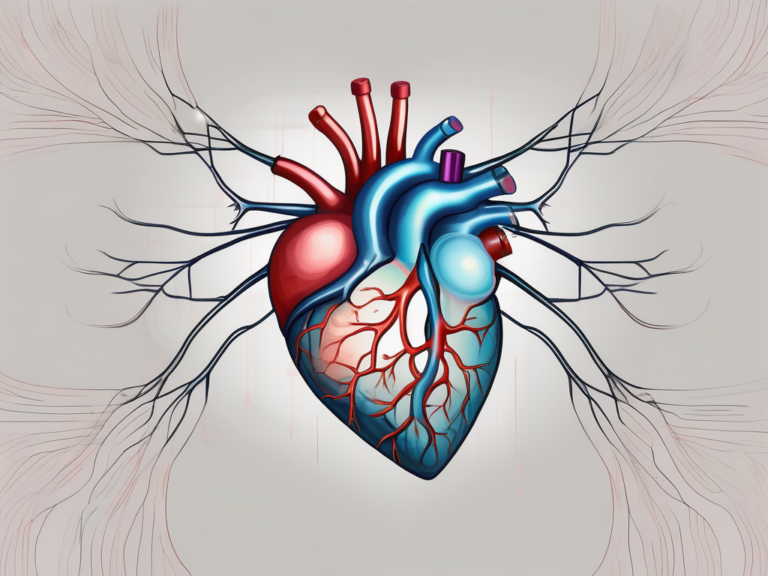Unveiling the Importance of the Abducens Nerve
Have you ever wondered how your eyes are perfectly synchronized as they dart from one object to another? It’s all thanks to the amazing abducens nerve! This tiny but mighty nerve plays a vital role in controlling eye movement and coordination. In this article, we will dive deep into the fascinating world of the abducens nerve and explore its anatomy, functions, disorders, and the exciting future research directions in abducens nerve health.
Understanding the Abducens Nerve
Before we delve into the intricate details of the abducens nerve, let’s first understand what it is. Located in the brainstem, the abducens nerve is responsible for controlling the movement of the lateral rectus muscle in each eye. This muscle helps in the outward movement of the eyes, allowing us to look sideways.
Anatomy of the Abducens Nerve
To truly appreciate the abducens nerve, let’s take a quick journey through its anatomy. Originating from the abducens nucleus in the brainstem, the nerve fibers travel through the cavernous sinus, which is a complex network of blood vessels located behind the eye socket. Finally, they reach their destination, the lateral rectus muscle in each eye.
As the nerve fibers navigate through the cavernous sinus, they encounter a bustling highway of blood vessels, creating a challenging environment. However, nature’s engineering marvel becomes evident as the abducens nerve gracefully weaves its way through this intricate network, ensuring that the vital signals reach their intended destination without any interruptions.
It’s truly remarkable how this nerve follows its intricate path, ensuring precise control over our eye movements. The abducens nerve reminds us of the intricate inner workings of our body, a masterpiece of nature’s engineering.
Functions of the Abducens Nerve
So, what makes the abducens nerve so important? Well, without the proper functioning of this nerve, our ability to move our eyes laterally would be greatly impaired. It not only allows us to scan our surroundings effortlessly but also contributes to our hand-eye coordination, making everyday tasks a breeze.
Furthermore, the abducens nerve plays a crucial role in maintaining the alignment of our eyes. Working in harmony with other cranial nerves, it ensures that both eyes are perfectly synchronized, preventing the occurrence of double vision. This seamless coordination allows us to perceive the world around us with clarity and accuracy.
Imagine a world where our eyes couldn’t effortlessly move laterally or where our vision was plagued by constant double images. The abducens nerve, with its intricate anatomy and vital functions, is a testament to the incredible complexity and precision of the human body.
Disorders Associated with the Abducens Nerve
Unfortunately, like all superheroes, the abducens nerve is not invincible. It can face certain disorders that can affect its proper functioning. Let’s take a closer look at some of these disorders and their impact.
The abducens nerve, also known as the sixth cranial nerve, plays a crucial role in eye movement by innervating the lateral rectus muscle. However, this vital nerve is susceptible to various disorders that can disrupt its function and lead to debilitating symptoms.
Causes of Abducens Nerve Palsy
Abducens nerve palsy refers to the weakness or paralysis of the lateral rectus muscle due to damage or compression of the abducens nerve. This condition can occur as a result of various factors, such as head trauma, infections, tumors, or certain medical conditions. Understanding the underlying cause is crucial in determining the appropriate treatment.
Damage to the abducens nerve can result from trauma, such as a head injury or surgical complications. Infections like meningitis or conditions such as multiple sclerosis can also affect the nerve’s function, leading to palsy. Additionally, the presence of tumors in the brain or along the nerve pathway can exert pressure on the abducens nerve, causing impairment.
Symptoms and Diagnosis of Abducens Nerve Disorders
When the abducens nerve is not functioning optimally, it can lead to symptoms such as double vision, eye misalignment, or difficulty moving the eyes laterally. These symptoms can be quite bothersome and interfere with daily activities. To diagnose abducens nerve disorders, doctors may perform a comprehensive eye examination, imaging tests, and evaluate medical history.
It is essential to differentiate between various causes of abducens nerve disorders, as the treatment approach may vary depending on the underlying issue. Early diagnosis and intervention are key in managing these conditions effectively and preventing long-term complications.
While it’s important to seek professional medical advice if you experience any concerning symptoms, remember that self-diagnosis is never a good idea. Let the experts handle it, and focus on taking care of your overall well-being.
Treatment Options for Abducens Nerve Disorders
When it comes to addressing disorders associated with the abducens nerve, several treatment options are available. Let’s explore these options, ranging from medical interventions to surgical procedures.
Abducens nerve disorders, also known as sixth cranial nerve palsy, can present a variety of challenges for individuals. These disorders can result in symptoms such as double vision, eye misalignment, and difficulty with eye movements. Seeking prompt and appropriate treatment is essential to improve quality of life and prevent further complications.
Medical Interventions
Sometimes, medical interventions such as eye patches or prism glasses may be recommended to help alleviate symptoms like double vision. In certain cases, medications or injections may also be used to reduce inflammation and improve nerve function. Additionally, vision therapy exercises may be prescribed to strengthen eye muscles and improve coordination. It is important for patients to follow their healthcare provider’s recommendations diligently to achieve the best possible outcomes.
Surgical Procedures
In severe cases where conservative management is not sufficient, surgical procedures may be considered. Surgical options aim to correct the underlying cause, relieve nerve compression, or improve muscle function. Procedures such as strabismus surgery or decompression surgery may be recommended based on the specific needs of the patient. While these interventions can offer significant benefits, they also carry risks such as infection, bleeding, or nerve damage. Patients should have detailed discussions with their healthcare team to fully understand the potential risks and benefits of surgical treatment.
The Role of the Abducens Nerve in Eye Movement
The abducens nerve doesn’t just play a crucial role in lateral eye movement; it also has fascinating connections to other aspects of our visual perception. Understanding the intricate workings of this nerve can shed light on how our eyes function in coordination with the brain and other cranial nerves.
One of the lesser-known functions of the abducens nerve is its involvement in depth perception. While commonly associated with lateral eye movement, this nerve also aids in judging distances and perceiving the three-dimensional nature of the world around us. By working in tandem with the visual cortex, the abducens nerve helps us navigate and interact with our environment seamlessly.
Coordinating Lateral Eye Movement
Whenever we shift our gaze, be it following a moving object or exploring our surroundings, the abducens nerve comes into play. It ensures that both of our eyes move harmoniously, allowing us to effectively track objects and absorb the world around us effortlessly.
Abducens Nerve and Double Vision
Double vision, also known as diplopia, can occur when the abducens nerve is not functioning properly. This condition can be disorienting and affect our quality of life. The abducens nerve works alongside other cranial nerves to maintain eye alignment, preventing the occurrence of double vision. In cases of abducens nerve palsy, double vision might be experienced.
Furthermore, the abducens nerve plays a crucial role in our ability to focus on objects at varying distances. By adjusting the position of the eyes through lateral movement, this nerve contributes to the convergence and divergence required for clear vision. Dysfunction of the abducens nerve can lead to difficulties in focusing, impacting tasks that require precise visual acuity.
Future Research Directions in Abducens Nerve Health
As our understanding of the abducens nerve continues to evolve, researchers and scientists are exploring potential therapies and interventions that hold promise for enhancing abducens nerve health.
One potential therapy that researchers are investigating is the use of stem cells. Stem cells have the remarkable ability to differentiate into various cell types, including nerve cells. By harnessing the regenerative potential of stem cells, scientists hope to develop treatments that can repair and regenerate damaged abducens nerves, restoring their function and improving overall eye movement.
Potential Therapies and Interventions
Advanced technologies, such as neurostimulation and regenerative medicine, are being investigated as potential avenues to promote nerve regeneration and enhance nerve function. These exciting developments bring hope for individuals affected by abducens nerve disorders, paving the way for a brighter future.
In addition to stem cell therapy, researchers are also exploring the potential of gene therapy in treating abducens nerve disorders. Gene therapy involves introducing specific genes into the body to correct genetic abnormalities or enhance the production of certain proteins. By targeting the underlying genetic causes of abducens nerve disorders, gene therapy holds the potential to provide long-lasting and targeted treatments.
The Impact of Advancements in Neurology
As advancements in the field of neurology continue at a rapid pace, we can expect innovative diagnostic techniques, more precise treatment modalities, and improved rehabilitation strategies for abducens nerve disorders. From cutting-edge imaging technologies to non-invasive interventions, the future of abducens nerve health looks promising.
Furthermore, the integration of artificial intelligence (AI) and machine learning algorithms into neurology research is revolutionizing the field. AI-powered algorithms can analyze vast amounts of data, identify patterns, and make predictions, enabling researchers to gain deeper insights into the complexities of abducens nerve disorders. This knowledge can then be translated into more personalized and effective treatment approaches.
In conclusion, the abducens nerve may be small in size, but its importance in our visual world cannot be overstated. From coordinating eye movements to maintaining eye alignment, this nerve is a superhero in our bodies. While disorders affecting the abducens nerve can cause challenges, the ever-evolving field of medicine offers a range of treatment options and holds the promise of new discoveries.
So, next time you effortlessly scan your surroundings, take a moment to appreciate the amazing abducens nerve and its remarkable role in our visual experience!






